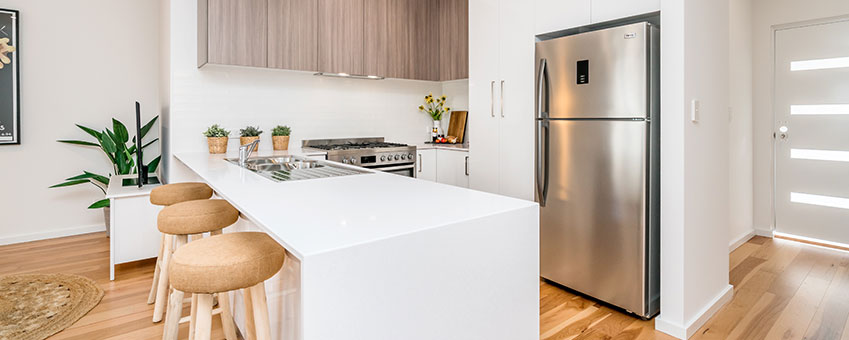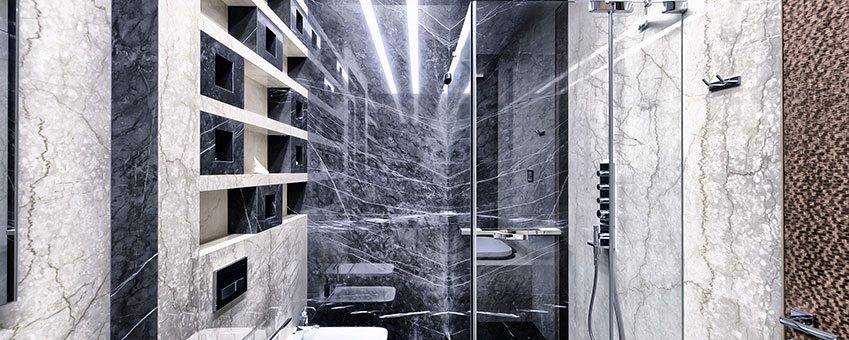Porcelain countertops are increasingly gaining popularity for their unique blend of style and functionality. But are they the right choice for everyone? Read on as we talk about the pros and cons of porcelain countertops and compare them to well-known alternatives like granite and quartz. Additionally, we’ll answer frequently asked questions about porcelain countertops.
The Pros of Porcelain Countertops
Aesthetic Appeal
Porcelain countertops are available in many different colors, patterns, and finishes. This will allow you to customize your countertop and match it to your kitchen.
Colors
Here is a range of colors you can work with when selecting porcelain countertops:
Neutral colors
Crisp whites, cool grays, and warm beiges are perfect for minimalist or contemporary designs.
Dramatic hues
Elegant black, deep navy, or rich chocolate brown for a bold statement.
Vibrant colors
Bright red, bold blue, or striking green to make a statement in any kitchen or bathroom.
Patterns
There are plenty of variations in porcelain patterns. The good news is you can select from patterns that showcase subtle or distinct details such as the following:
Natural stone lookalikes
Marble, granite, or travertine for a luxurious and timeless appearance.
Modern and industrial styles
Options that resemble concrete or metal surfaces.
Wood-look porcelain countertops
Combining the warmth and texture of wood with the durability and easy maintenance of porcelain.
Finishes
Porcelain finishes give it a final top layer of protection and allow you to tweak its final look to your liking. Some finishes include:
Polished and glossy
Providing a sleek, reflective surface that can make a space feel larger and more open.
Matte
This creates a subtle yet sophisticated look that fits in modern and traditional spaces alike.
Textured
Opting for added texture to a finish gives the look of stone and naturally adds depth and dimension to the countertop.
Long-lasting and Easy to Maintain
Porcelain countertops are made of a sturdy, non-porous material that resists scratches, stains, and heat. They need minimal upkeep—usually just a damp cloth wipe-down. Unlike some countertop materials, porcelain doesn’t need frequent sealing to preserve its look.
Environmentally Friendly Alternative
Porcelain is one of the most environmentally friendly building materials out there. Because it’s made from natural materials, namely clay and stone, it degrades naturally. You don’t have to worry about toxic chemicals like VOCs (volatile organic compounds) leaching out of them both in your home and after disposal. On top of that, processing porcelain has a smaller carbon footprint than other building materials such as laminate.
The Cons of Porcelain Countertops
Installation Challenges
Due to the sturdy and heavy nature of porcelain, it takes specialized tools and a professional to install it properly. As a result, porcelain costs more to install. For instance, you can expect to shell out anywhere between $47 to $108 per square foot of porcelain installed. In comparison, granite countertop installation ranges from $35 to $85.
Limited Edge Profile Options
For porcelain countertop edges, you typically only have two design options readily available: square or mitered. While there’s nothing inherently wrong with this, square or mitered edges won’t suit everyone’s design preferences. If you want porcelain countertops with custom edges, be ready to add extra to the material’s overall cost.
Susceptibility to Chipping and Repair Challenges
While porcelain countertops resist scratches and heat, they may be vulnerable to chipping, particularly at the edges. Fixing a chipped porcelain countertop can be challenging and, at times, expensive, depending on the damage’s severity.
Repairing a Chipped Porcelain Countertop
Assess the Damage
Before you begin, carefully examine the chip or crack to determine its size and depth. Minor chips can often be repaired with a DIY approach, while larger or more complex damage may require professional assistance.
Clean the Area
Thoroughly clean the chipped area with a mild soap and water solution to remove dirt, grease, and debris. Allow the surface to dry completely before proceeding to the next step.
Choose the Repair Material
If you have porcelain countertops, you’d be remiss to not have a repair kit on hand. With that said, you can address minor chips and cracks with a readily available repair kit. Choose accordingly. Porcelain repair kits will contain a type of porcelain filler to address minor damage. For obvious reasons, you’ll want a kit that has a filler that matches your porcelain countertop.
Apply the Filler
Refer to your repair kit’s instructions on how to prep the porcelain filler. Using a spatula or a putty knife, apply the filler to the damaged areas. Keep the application smooth and even. Remember, less is more. You’ll want to fill in the cracks to restore a smooth and even surface. Remove any excess filler before it dries to avoid an uneven surface.
Allow to Dry
Allow the filler to dry and cure according to the recommended time. This may vary based on the repair kit you’re using, so be sure to follow the provided guidelines.
Sand the Surface
Once the filler has dried and cured, use fine-grit sandpaper to gently sand the repaired area until it is smooth and level with the surrounding countertop surface.
Polish and Seal (if necessary)
Depending on the repair kit and your countertop’s finish, you may need to apply a polish or sealer to the repaired area to match the rest of the countertop. Follow the manufacturer’s instructions for this step.
Preventing Chipping
Use Cutting Boards
Avoid cutting directly on your porcelain countertop, as this can lead to chipping or scratches. Always use a cutting board to protect the surface.
Exercise Caution with Heavy Objects
Be careful when placing heavy pots, pans, or appliances on your countertop. Gently set them down to avoid accidentally chipping the surface or edges.
Round or Bevel the Edges
If you’re installing a new porcelain countertop, consider opting for rounded or beveled edges, as these tend to be less prone to chipping than sharp, square edges.
Porcelain Countertops vs. Granite and Quartz
Comparing Costs
When we talk about expenses, porcelain countertops might be easier on the wallet than granite, depending on the specific materials and installation charges. However, they could be a tad pricier than quartz countertops, which are renowned for their budget-friendly nature.
Durability & Upkeep
All three materials – porcelain, granite, and quartz – boast durability and longevity. But porcelain countertops have a slight advantage when it comes to being low-maintenance. In contrast to granite, they don’t need regular sealing to preserve their looks, and they’re less susceptible to stains.
Diverse Design Possibilities
Porcelain countertops offer greater design versatility compared to granite and quartz. With a wide array of colors, patterns, and finishes, homeowners can effortlessly find the perfect fit for their aesthetic preferences.
Customization Options
Porcelain countertops offer the flexibility to tailor them to your unique design goals. This allows you to pick the dimensions, contours, and edge profiles that best harmonize with the overall vision for your kitchen.
For instance, you might opt for a waterfall edge to exude a modern vibe or choose a classic ogee edge for a timeless, elegant appeal. Furthermore, if you’re already purchasing porcelain countertops, you can get porcelain slabs and trim them into smaller segments. You can use this for backsplashes, islands, or other design elements, delivering a unified and seamless look across your kitchen.
Heat and Stain Resistance
The heat and stain-resistant qualities of porcelain make it a top choice for kitchen countertops where hot cookware and spills are frequent. For instance, a light-toned porcelain countertop not only illuminates your space but also resists staining from coffee, wine, and other substances that could harm or discolor alternative materials.
Frequently Asked Questions
Are porcelain countertops capable of withstanding high heat?
Porcelain countertops can withstand high heat. The material can endure temperatures reaching 1,200°F without any damage, making them ideal for kitchens where hot cookware is in regular use.
How do I clean and maintain my porcelain countertops?
Cleaning porcelain countertops is simple – just use a damp cloth and mild detergent to wipe the surface. For tougher stains, use a non-abrasive cleaner made for porcelain. Keep in mind that porcelain countertops don’t need sealing, so they’re low-maintenance compared to other materials.
Are porcelain countertops suitable for outdoor use?
Yes, porcelain countertops work well outdoors due to their resistance to heat, UV rays, and temperature fluctuations. They’re an excellent choice for outdoor kitchens, patios, and entertaining spaces.
The Final Verdict on Porcelain Countertops
Porcelain countertops provide a desirable mix of style, durability, and easy upkeep, making them a popular choice for homeowners. Despite some downsides, like installation difficulties and limited edge profiles, the advantages often surpass these issues for those seeking a durable, high-quality countertop. With flexible design choices and environmental friendliness, they can be a fashionable and practical addition to any kitchen.




